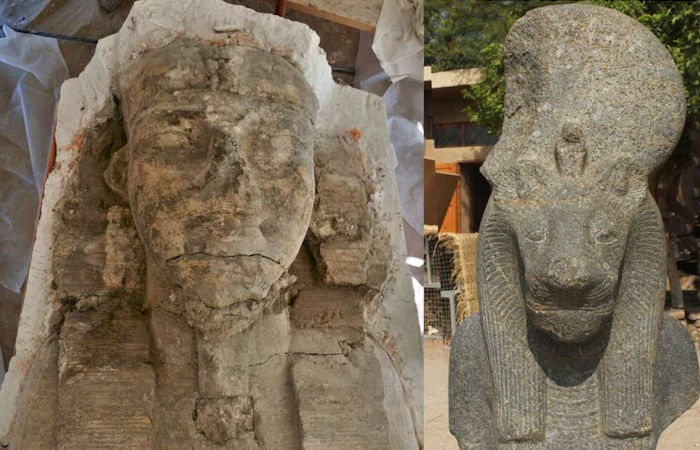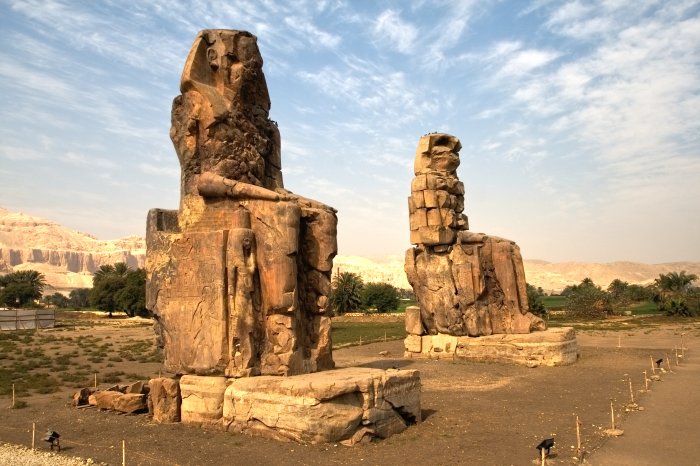Conny Waters – AncientPages.com – While carrying out recent restoration works on the statues of Memnon and the “Temple of Millions of Years” on the western mainland in Luxor, southern Egypt, a German-Egyptian archaeology team has uncovered two giant limestones sphinxes depicting an ancient Pharaoh.

Credit: Ministry of Tourism and Antiquities
The Ministry of Tourism and Antiquities announced scientists found “huge stones for two royal statues in the form of the Sphinx, and the goddess Sekhmet, in addition to revealing the remains of walls and columns decorated with ceremonial and ritual scenes.” The two sphinxes once measured about eight meters long.
Dr. Mustafa Waziri, Secretary-General of the Supreme Council of Antiquities, explained that among the discovered pieces were parts of two colossal limestone statues of King AmenH๏τep III in the form of a Sphinx, wearing a mongoose headdress, a royal beard, and a wide necklace around the neck, which were found in the back area. The Gate of the Third Pylon indicates that all the pieces of these two statues have undergone careful cleaning, strengthening, and restoration, which showed the presence of an inscription in the chest area bearing the royal name of AmenH๏τep III; which is “the beloved of the god Amun-Ra.”
He added that the mission also found three black granite busts of the goddess Sekhmet at the front of the open courtyard and the great pillared hall of the temple. These pieces will be grouped with other pieces found earlier at the site in preparation for displaying them in their original places in the temple.
Some bases for columns and stone blocks were found in the southern half of the great pillared hall, which shows that this hall was more extensive than what is known with more columns. Studies indicated that it is likely that this statue dates back to the post-Amarna period when the works continued restoration in this temple by artists and writers.
These pieces were moved from the places they were discovered inside the temple for restoration and re-installation, where the original colors of many of them appeared, in preparation for re-placing them in their actual places in the temple.

Colossi of Memnon, Egypt. Credit: Adobe Stock – erichon
Dr. Horig Sorosian, head of the mission, emphasized the importance of this discovery, stating these two giant statues in the form of the Sphinx confirm the presence of the beginning of the procession road, which lies between the third tower of the temple and the courtyard of the columns. “This discovery shed light on the processional way from the third pylon to the Peristyle Court,” Sourouzian told Al-Monitor. “In the peristyle, the newly discovered pieces of wall relief reveal new scenes of the Heb-Sed, a festival of the king started after 30 years of his rule and repeated every three years thereafter.”
See also: More Archaeology News
It should be noted that the project to restore the statues of Memnon and the temple of King AmenH๏τep III began in 1998 under the supervision of the Ministry of Tourism and Antiquities and the German Insтιтute of Archeology to preserve the remains of the temple and rebuild it again.
As previously explained on AncientPages.com, “for the last 3,400 years, since 1350 BC, two gigantic stone statues known as the Colossi of Memnon have been guarding Pharaoh AmenH๏τep III’s temple. He was worshiped as a god-on-earth both before and after his departure from this world.
AmenH๏τep III’s mortuary temple is located on the Western bank of the Nile River, across from the Eastern bank city of Luxor, and originally is considered the largest temple ever erected in Egypt. The temple was also known as the “house of millions of years’, ” surrounded by an enclosure wall measuring 700 x 550 m, 8.5 m thick. Only a small amount of debris is visible today.
A huge stele stands about a quarter of a mile behind the Colossi monuments. Around are scattered fragments of various sculptures and monuments. There was an avenue of sphinxes, countless statues of Sekhmet, stelae, alabaster sphinxes with crocodile tails, and sandstone sphinxes with Anubis heads, and a life-size alabaster statue of a hippopotamus. Also within the enclosure wall were additional brick buildings, gardens, lakes, and a temple to Sokar.”
Pharaoh AmenH๏τep III’s temple was destroyed due to a devastating earthquake that swept the country during ancient Egyptian times.
Written by Jan Bartek – AncientPages.com Staff Writer





